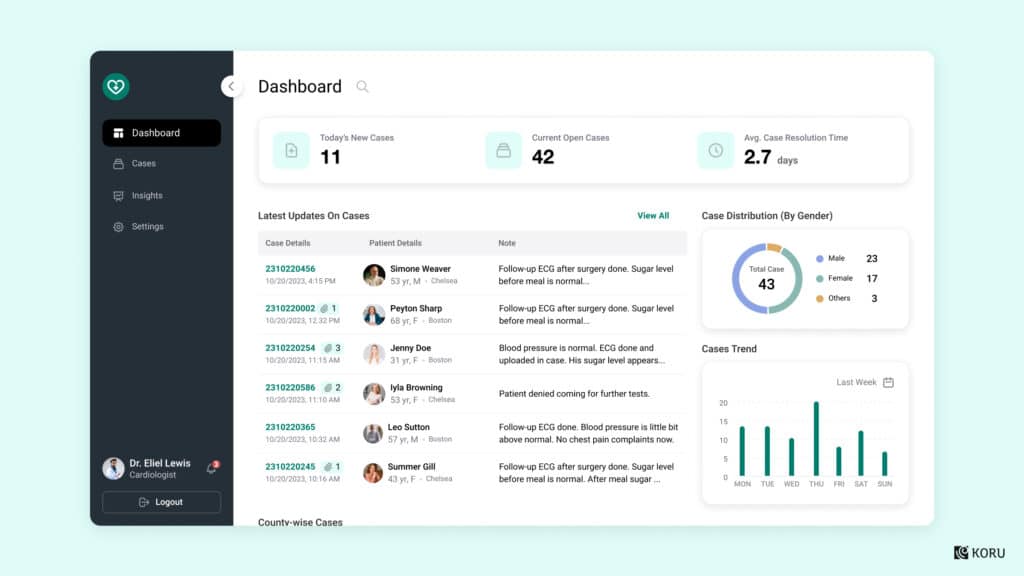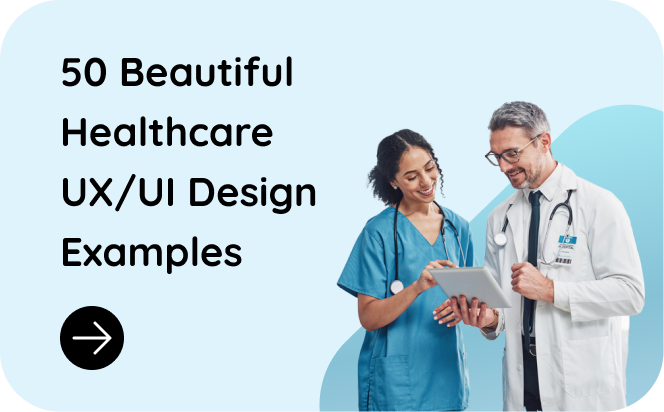Imagine this…
You’ve undergone a barrage of medical tests for a persistent niggle, and it’s finally time for your doctor’s appointment. Your anxiety is through the roof.
The receptionist at the clinic turns out to be a friendly AI interface. It welcomes you and directs you to wait until your turn arrives. It communicates the reason for your visit and announces your waiting period – approximately 20 minutes.
20 antagonizing minutes while you wait to see your doctor and know what’s in store for you.
The question is, can this zippy tech ever truly understand what you’re going through?
Can it assuage your anxiety? Can it make you feel relieved at least for a few moments before you meet your doctor?
Buckle up, because we’re about to dissect AI’s potential to match (or maybe even enhance?) that crucial human touch in healthcare UX design.
Empathy: A Driving Force in Healthcare Delivery
Empathy in healthcare isn’t just about being nice, using polite tones, or being patient.
It’s about making decisions that would create a real difference in healthcare outcomes.
But what does it mean to design with empathy? Several things, actually.
It may mean a goal to significantly reduce patient anxiety, ensure patients stick to their treatment plans, or foster a deep sense of trust between patients, caregivers, and healthcare providers.
It can also mean creating experiences that take into account the chaos in emergency rooms, the emotional turmoils of palliative care centers, or the fatigue and chronic stress that providers and clinical staff go through.
The empathetic approach goes beyond creating sleek interfaces; it’s about shaping the entire healthcare journey.
From the initial diagnosis to the final stages of treatment and recovery, empathy ensures that everyone in the healthcare ecosystem feels understood, respected, and attended to – be it patients, their families, healthcare providers, insurers, or pharmacists.
This humane connection is a primary necessity for effective healthcare delivery.
AI in Healthcare UX: Where does it stand?
We’re living in exciting times, at least technology-wise. And I’m not even considering IBM’s Watson!
Times where predictive analytics can help in the timely detection of diseases and create hyper-personalized treatment plans. Oncologists, for instance, are using AI to analyze genetic profiles of cancer patients alongside clinical trial data.
Philips has listed 10 real-world examples of AI in healthcare that are in use, and this is just the tip of the iceberg.
Google’s DeepMind has already developed algorithms capable of predicting patient deterioration in hospitals, facilitating timely interventions.
Top 10 AI-led HealthTech innovations creating a buzz
1. Early Disease Detection in Population Health Management
AI can analyze vast datasets from wearables, portable medical devices, and electronic health record systems (EHRs). The AI identifies patterns indicative of early stages of chronic diseases like diabetes or cardiovascular conditions, enabling proactive interventions and personalized wellness programs.
Last year, we designed a module to help primary healthcare providers’ capacity to screen, test, and treat Cardiovascular Disease in remote regions. The solution is a simple, user-friendly application for frontline healthcare providers that would help them share data from electrocardiographic screenings done in rural regions with specialist providers at the district level. It further applies AI-powered data analysis models of cases to help providers spot trends and anomalies within the huge number of at-risk rural populations. This is key to implementing preventive measures at the community level and making high-quality healthcare accessible to the most vulnerable.
Read the iF Design Award-winning case study here.

2. Predicting Patient Deterioration in Hospitals
The Mayo Clinic uses AI-driven predictive analytics to anticipate patient deterioration and adjust care protocols accordingly. The AI model monitors patient vitals and clinical notes in real-time and predicts which patients are likely to deteriorate, allowing healthcare providers to intervene before critical events occur.
3. Optimizing Emergency Department Operations
An emergency department utilizes AI to predict patient inflow patterns based on historical data, seasonal trends, and local events. This helps in staffing optimization and resource allocation, reducing wait times and improving patient care – something that Penn Medicine’s emergency department is already doing to forecast patient arrivals and optimize staffing levels.
4. AI-Powered Virtual Health Assistants
A good example comes from Babylon Health’s chatbot. Enhanced with NLP techniques that detect and respond to signs of distress or confusion, it recognizes and responds appropriately to patients’ emotional states, suggesting human assistance when needed.
5. Clinical Decision Support for Doctors
We designed an AI system that provides doctors with predictive analytics for diagnosing complex conditions by analyzing combined patient data and medical literature using digital twin technology.
This healthcare module creates digital twins in the metaverse to model organs and single cells or an individual’s genetic makeup, physiological characteristics, and lifestyle habits. ML- and AI-driven algorithms rely on data fusion, i.e. the integration of big data from several data sources containing heterogeneous information to run diagnostic tests safely and securely and deliver personalized medicine and treatment plans.
6. Continuous Professional Development for Clinicians
AI-driven platforms can offer personalized learning and training modules for clinicians, helping them stay updated with the latest medical advancements and practices. The training content can be customized to address the emotional and psychological aspects of patient care. It can also include modules that focus on building empathetic communication skills and managing stress.
7. Streamlined Administrative Tasks for Pharmacists
AI is already automating routine administrative tasks for pharmacists, such as medication management, inventory control, and prescription verification.
These AI-driven systems can be further enhanced to provide sensitivity alerts and reminders. For example, when a prescription change might cause patient anxiety, the system can prompt the pharmacist to offer reassurance and additional information.
8. Automated Patient Follow-Up Systems
A hospital can make use of AI to automate post-discharge follow-ups.
This kind of AI-powered system can send personalized messages to patients, check on their recovery progress, and prompt them to complete post-care surveys, reducing readmission rates.
Here’s a glimpse of how it looks in action –

9. AI-Enhanced Customer Support in Healthcare
A health insurance provider can integrate AI into its customer service operations to handle initial inquiries, resolve common issues, and escalate complex cases to human agents, ensuring efficient and personalized support.
10. Resource Allocation for Hospital Administrators
GE Healthcare’s Command Center can integrate features that suggest empathetic scheduling practices, balancing efficiency with the mental health and job satisfaction of healthcare staff.
So you see, AI can help hospital administrators predict resource needs, such as staffing, equipment, and bed availability, based on patient inflow and other factors. It can provide recommendations that help administrators allocate resources while minimizing staff burnout and ensuring a supportive work environment.
Here’s where things get interesting…
We’re not talking about a man vs. machine showdown. The future of healthcare design lies in a powerful synergy between human and artificial intelligence.
AI can be a force multiplier for human designers. It can automate tedious tasks, analyze user data for hidden patterns, and free up valuable time for the irreplaceable human touch.
Think about it. Designers armed with AI insights can create experiences that truly resonate with patients.
Imagine a pre-surgery app that uses AI to identify a patient’s anxiety level, and then adapts its interface with calming visuals and soothing music.
Or a post-discharge app that leverages AI to personalize reminders and educational content based on a patient’s specific condition.
The potential is simply phenomenal!
But, before we press down on the accelerator…
Remember, data doesn’t capture feelings (or at least, it can’t for now).
Despite AI’s capabilities, it has inherent limitations when it comes to understanding the subtle nuances of human emotions. Data, no matter how sophisticated, falls short of capturing nonverbal cues, cultural contexts, and individual experiences that shape emotional responses.
Consider this: a patient’s tone of voice, facial expressions, and body language can reveal critical information about their emotional state—information that AI systems may struggle to interpret accurately. Additionally, cultural differences can influence how emotions are expressed and understood, adding another layer of complexity for AI to navigate.
From MR and CT image analysis and brain scanning, to home-care services, AI-driven algorithms are providing data-based insights that enable quick action from providers, resulting in improved delivery of care.
We’re seeing algorithms churn out data-driven insights, automate repetitive tasks, and even personalize user experiences. It’s a wave of innovation that’s undeniably powerful.
But here’s the million-dollar question: can AI ever truly replicate the human touch, specifically empathy, in healthcare design?
Empathy, after all, isn’t just about usability. It’s about understanding the emotional rollercoaster that healthtech users navigate – the anxieties of diagnosis, the fear of procedures, and the yearning for comfort and reassurance.
It’s about designing not just interfaces, but an entire healthcare journey that acknowledges the human element.
AI-led HealthTech with Emotional Intelligence? Sure, why not?
Empathy in UX design involves understanding users’ emotions, contexts and needs to develop solutions that resonate on a personal level.
For AI tech, this means creating systems that can anticipate and respond to human emotions and behaviors in a meaningful way. AI can mimic empathy or even fake it, but it can’t really feel it.
This is where the human element becomes indispensable. We can feel empathy via our neural networks that allow us to truly imagine problems or futures that make our solutions better.
As UX designers, we hold a pivotal role in shaping AI technologies by determining which problems to solve and framing these problems in a way that prioritizes empathy. This is the only way to ensure that AI-driven solutions are not only efficient but also genuinely considerate of human experiences.
Techniques for Empathetic Problem Framing
User Personas and Journey Maps are unbeatable when it comes to visualizing the user’s emotional journey and identifying key touchpoints where empathy can be integrated.
For instance, in a customer service scenario, a journey map might highlight points of frustration where users are likely to need more empathetic support.
Empathy Mapping is a fabulous technique to understand what users are thinking, feeling, saying, and doing. It helps frame problems in a way that addresses not just the functional, but also the emotional and psychological needs of the user.
Problem Statements incorporating emotional language can guide the design process towards more empathetic solutions. For example, instead of framing a problem as “Users need faster access to their account information”,
an empathetic problem statement might be,
“Users feel anxious when they can’t quickly access their account information, leading to frustration and distrust”.
The first step in creating empathy-led AI technology is to identify the right problems to solve. As designers, we employ multiple methods to uncover user needs and pain points, including user research, interviews, and ethnographic studies.
This is what ensures that the focus is on real, human-centric issues rather than abstract technological challenges.
The future of AI in healthcare UX design isn’t about replicating empathy. It’s about amplifying human empathy by leveraging the power of data and automation. Let’s not forget, AI is still evolving.
Maybe someday – and that day isn’t too far in the future – advancements in natural language processing and sentiment analysis will allow AI to grasp human emotions on a deeper level. But even then, the human capacity for empathy will remain irreplaceable. It’s the cornerstone of trust, connection, and ultimately, a healthcare experience that empowers patients and fosters well-being.
So, the next time you hear about AI in healthcare design, remember: it’s not about replacing the human touch, it’s about working together to create a future where empathy is the driving force behind every healthcare experience.









